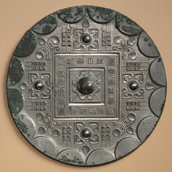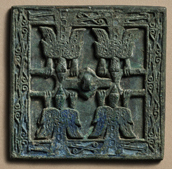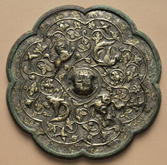An outstanding private collection of ancient Chinese bronze mirrors owned by Lloyd Cotsen is being donated to the Shanghai Museum according to press releases issued in China and by The Huntington in San Marino, California.
Lloyd Cotsen, a successful American entrepreneur and noted philanthropist, began collecting ancient Chinese mirrors in the 1950’s after being exposed to Chinese art as an undergraduate at Princeton University. His collection of 95 pieces includes mirrors from the “Qijia Culture” (齐家文化 2100-1700 BC) as well as specimens produced during the Warring States Period, the Tang and later dynasties.
The collection will be exhibited at The Huntington from November 2011 to May 2012, and then will be transferred to the Shanghai Museum in China for permanent display.

Western Han Dynasty Inscribed Mirror
At the left is a mirror from the Cotsen collection which is one of the earliest to include an inscription. The inscription on this Western Han Dynasty (206 BC-24 AD) mirror reads:
長貴福樂無事日有熹宜酒食常得君喜
“May you enjoy noble status and blessings for a long time. May you have pleasure without incident. May you have brightness every day. May you have plentiful wine and food. And may you regularly obtain lordly delights.”
The museum describes the piece as “quatrefoil, grass motifs, stars, and linked arc” incorporating cosmic symbols of space, time, earth and the heavens.

Mirror from Warring States Period
This mirror was produced even earlier during the Warring States Period (475-221 BC).
It is unusual in being layered or “tiered” and, unlike most mirrors, is square instead of round.
In ancient Chinese cosmology, the earth was believed to be “square” while “the heavens” were seen to be “round”.
The museum describes this as a “square double tier mirror with four opposed birds”.

Tang Dynasty Mirror
The mirror at the left dates from the Tang Dynasty (618-907).
According to the museum, it is an “eight-lobed mirror with vines, birds, and mythical animals”.
The surface is covered with “hammerings” which are small pieces of soft metal placed over a carved form, tapped into shape with a hammer, and then attached to the mirror.
The vines, birds and mythical animals on this mirror were all created in this manner.
The mirror also exhibits “chasing” which is a technique for making intricate detail and texture on the surface of a mirror by using a hard stylus tapped with a hammer.
Mr. Cotsen explained at the press conference in California that he decided to donate his collection of ancient Chinese mirrors to the Shanghai Museum because of its reputation and commitment to public education.
Mr. Chen Kelun (陈克伦), the Deputy Director of the Shanghai Museum (上海博物馆副馆长), commented that the mirrors were exquisite. He said that no data existed for some of them which means that they will be very valuable for research.
Mr. Cotsen began his collecting in the 1950’s and acquired his first set of Chinese bronze mirrors at an auction in Hong Kong. He did not know it at the time but the other key bidder was the Swedish government bidding on behalf of the King of Sweden.